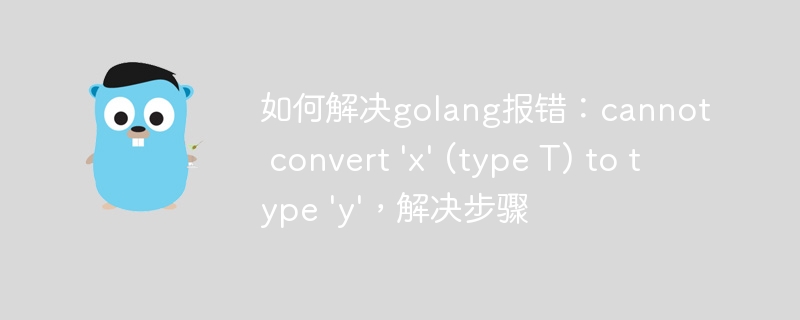Home >Backend Development >Golang >How to solve golang error: cannot convert 'x' (type T) to type 'y', solution steps
How to solve golang error: cannot convert 'x' (type T) to type 'y', solution steps
- 王林Original
- 2023-08-26 23:32:00729browse

How to solve golang error: cannot convert 'x' (type T) to type 'y', solution steps
When we are writing golang programs, sometimes Encountered such an error message: cannot convert 'x' (type T) to type 'y', which means that we tried to convert a variable x of data type T into a variable of data type y, but the compiler detected This conversion is illegal. In this article, we'll describe how to solve this problem and provide some code examples.
- Understanding the error message
First of all, we need to understand the reason for the error. In golang, type conversion must be legal, that is, the two types must be compatible. If no conversion rules are defined between the two data types, the compiler will throw this error. - Check data type
Before solving the error, we need to ensure that the data type of the variable we operate is correct. Sometimes, we may make a low-level mistake, such as mistakenly assigning an int type variable to a string type variable. In this case, we just need to fix the error. -
Use type assertion
If the data type is correct, we can try to use type assertion to solve the problem. Type assertion is a method of converting an interface type to another concrete type. We can use the following syntax for type assertion:result, ok := x.(T)
where x is the variable we want to convert, and T is the target type we want to convert to. ok is a boolean value that is true if the conversion is successful, false otherwise. We can determine whether the conversion was successful by checking the value of ok.
The following is an example:
package main
import "fmt"
func main() {
var x interface{} = "hello"
// 类型断言
result, ok := x.(string)
if ok {
fmt.Println(result)
} else {
fmt.Println("类型断言失败")
}
}In this example, we perform type assertion on a string type variable x and convert it to string type. If the conversion is successful, we will print out the value of result (i.e. the string "hello"), otherwise we will print out "Type assertion failed".
- Use type conversion functions
Another solution is to use type conversion functions for type conversion. Golang provides some built-in type conversion functions. For example, some functions in the strconv package can convert strings to int, float and other types. We can choose the appropriate type conversion function for conversion according to our needs.
The following is an example:
package main
import (
"fmt"
"strconv"
)
func main() {
x := "100"
// 类型转换
result, err := strconv.Atoi(x)
if err == nil {
fmt.Println(result)
} else {
fmt.Println("类型转换失败")
}
}In this example, we use the strconv.Atoi function to convert the string variable x to int type. If the conversion is successful, we will print out the value of result (i.e. the integer 100), otherwise we will print out "Type conversion failed".
Summary:
In golang, when we encounter an error such as cannot convert 'x' (type T) to type 'y', we can first check whether the data type is correct. If the data type is correct, we can try to use type assertions or type conversion functions to solve the problem. By understanding the error message, carefully checking the code, and choosing the appropriate solution based on your needs, we can successfully solve this problem.
The above is the detailed content of How to solve golang error: cannot convert 'x' (type T) to type 'y', solution steps. For more information, please follow other related articles on the PHP Chinese website!
Related articles
See more- How to Send Private Messages to Specific Clients in Go with Gorilla Websocket?
- How to Strip Debugging Information from Go Code with `gc`?
- Docker: Why Am I Getting 'Permission Denied' When Running My Container?
- How to Handle Plain Text HTTP GET Responses in Go?
- What Are the Benefits and Applications of Empty Structs in Go?

